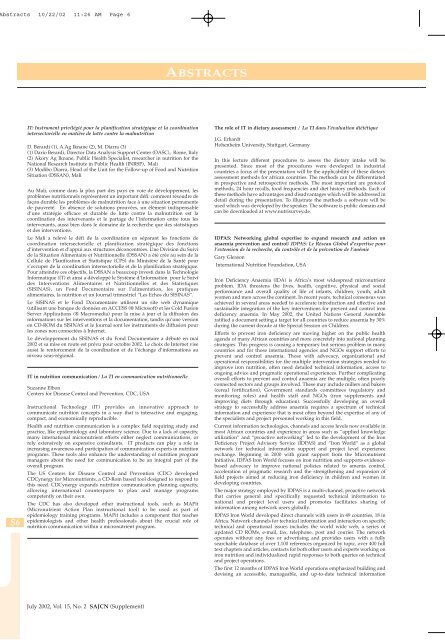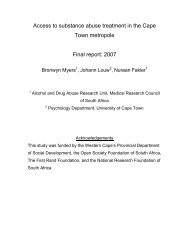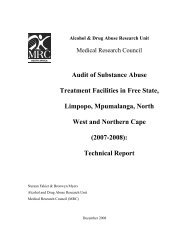Pan-African Conference 21 - 24 July 2002 Inter-Continental Hotel ...
Pan-African Conference 21 - 24 July 2002 Inter-Continental Hotel ...
Pan-African Conference 21 - 24 July 2002 Inter-Continental Hotel ...
You also want an ePaper? Increase the reach of your titles
YUMPU automatically turns print PDFs into web optimized ePapers that Google loves.
Abstracts 10/22/02 11:26 AM Page 6<br />
S6<br />
IT: Instrument privilégié pour la planification stratégique et la coordination<br />
intersectorielle en matière de lutte contre la malnutrition<br />
D. Berardi (1), A.Ag Iknane (2), M. Diarra (3)<br />
(1) Dario Berardi, Director Data Analysis Support Center (DASC), Rome, Italy<br />
(2) Akory Ag Iknane, Public Health Specialist, researcher in nutrition for the<br />
National Research Institute in Public Health (INRSP), Mali<br />
(3) Modibo Diarra, Head of the Unit for the Follow-up of Food and Nutrition<br />
Situation (DSSAN), Mali<br />
Au Mali, comme dans la plus part des pays en voie de développement, les<br />
problèmes nutritionnels représentent un important défi: comment résoudre de<br />
façon durable les problèmes de malnutrition face à une situation permanente<br />
de pauvreté. En absence de solutions prouvées, un élément indispensable<br />
d’une stratégie efficace et durable de lutte contre la malnutrition est la<br />
coordination des intervenants et le partage de l’information entre tous les<br />
intervenants, aussi bien dans le domaine de la recherche que des statistiques<br />
et des interventions.<br />
Le Mali a relevé le défi de la coordination en séparant les fonctions de<br />
coordination intersectorielle et planification stratégique des fonctions<br />
d’intervention et d’appui aux structures déconcentrées. Une Division du Suivi<br />
de la Situation Alimentaire et Nutritionnelle (DSSAN) a été crée au sein de la<br />
Cellule de Planification et Statistique (CPS) du Ministère de la Santé pour<br />
s’occuper de la coordination intersectorielle et de la planification stratégique.<br />
Pour atteindre ces objectifs, la DSSAN a beaucoup investi dans la Technologie<br />
Informatique (IT) et ainsi a développé le Système d’Information pour le Suivi<br />
des <strong>Inter</strong>ventions Alimentaires et Nutritionnelles et des Statistiques<br />
(SISINAS), un Fond Documentaire sur l’alimentation, les pratiques<br />
alimentaires, la nutrition et un Journal trimestriel “Les Echos du SISINAS”.<br />
Le SISINAS et le Fond Documentaire utilisent un site web dynamique<br />
(utilisant une banque de données en ACCESS (® Microsoft) et les Cold Fusion<br />
Server Applications (® Macromedia) pour la mise à jour et la diffusion des<br />
informations sur les interventions et la documentation, tandis qu’une version<br />
en CD-ROM du SISINAS et le Journal sont les instruments de diffusion pour<br />
les zones non connectées à <strong>Inter</strong>net.<br />
Le développement du SISINAS et du Fond Documentaire a débuté en mai<br />
<strong>2002</strong> et sa mise en route est prévu pour octobre <strong>2002</strong>. Le choix de <strong>Inter</strong>net vise<br />
aussi le renforcement de la coordination et de l’échange d’informations au<br />
niveau sous-régional.<br />
IT in nutrition communication / La TI en communication nutritionnelle<br />
Suzanne Elbon<br />
Centers for Disease Control and Prevention, CDC, USA<br />
Instructional Technology (IT) provides an innovative approach to<br />
communicate nutrition concepts in a way that is interactive and engaging,<br />
compact, and economically reproducible.<br />
Health and nutrition communication is a complex field requiring study and<br />
practice, like epidemiology and laboratory science. Due to a lack of capacity,<br />
many international micronutrient efforts either neglect communications, or<br />
rely extensively on expensive consultants. IT products can play a role in<br />
increasing awareness and participation of communication experts in nutrition<br />
programs. These tools also enhance the understanding of nutrition program<br />
managers about the need for communication to be an integral part of the<br />
overall program.<br />
The US Centers for Disease Control and Prevention (CDC) developed<br />
CDCynergy for Micronutrients, a CD-Rom based tool designed to respond to<br />
this need. CDCynergy expands nutrition communication planning capacity,<br />
allowing international counterparts to plan and manage programs<br />
competently on their own.<br />
The CDC has also developed other instructional tools, such as MAPit<br />
(Micronutrient Action Plan instructional tool) to be used as part of<br />
epidemiology training programs. MAPit includes a component that teaches<br />
epidemiologists and other health professionals about the crucial role of<br />
nutrition communication within a micronutrient program.<br />
<strong>July</strong> <strong>2002</strong>, Vol. 15, No. 2 SAJCN (Supplement)<br />
ABSTRACTS<br />
The role of IT in dietary assessment / La TI dans l’évaluation diététique<br />
J.G. Erhardt<br />
Hohenheim University, Stuttgart, Germany<br />
In this lecture different procedures to assess the dietary intake will be<br />
presented. Since most of the procedures were developed in industrial<br />
countries a focus of the presentation will be the applicability of these dietary<br />
assessment methods for african countries. The methods can be differentiated<br />
in prospective and retrospective methods. The most important are protocol<br />
methods, <strong>24</strong> hour recalls, food frequencies and diet history methods. Each of<br />
these methods have advantages and disadvantages which will be addressed in<br />
detail during the presentation. To illustrate the methods a software will be<br />
used which was developed by the speaker. The software is public domain and<br />
can be downloaded at www.nutrisurvey.de.<br />
IDPAS: Networking global expertise to expand research and action on<br />
anaemia prevention and control/ IDPAS: Le Réseau Global d’expertise pour<br />
l’extension de la recherche, du contrôle et de la prévention de l’anémie<br />
Gary Gleason<br />
<strong>Inter</strong>national Nutrition Foundation, USA<br />
Iron Deficiency Anaemia (IDA) is Africa’s most widespread micronutrient<br />
problem. IDA threatens the lives, health, cognitive, physical and social<br />
performance and overall quality of life of infants, children, youth, adult<br />
women and men across the continent. In recent years, technical consensus was<br />
achieved in several areas needed to accelerate introduction and effective and<br />
sustainable integration of the key interventions for prevent and control iron<br />
deficiency anaemia. In May <strong>2002</strong>, the United Nations General Assemble<br />
ratified a document setting a target for all countries to reduce anaemia by 30%<br />
during the current decade at the Special Session on Children.<br />
Efforts to prevent iron deficiency are moving higher on the public health<br />
agenda of many <strong>African</strong> countries and more concretely into national planning<br />
strategies. This progress is causing a temporary but serious problem in many<br />
countries and for those international agencies and NGOs support efforts to<br />
prevent and control anaemia. Those with advocacy, organizational and<br />
operational responsibilities for the multiple intervention strategies needed to<br />
improve iron nutrition, often need detailed technical information, access to<br />
ongoing advice and pragmatic operational experiences. Further complicating<br />
overall efforts to prevent and control anaemia are the multiple, often poorly<br />
connected sectors and groups involved. These may include millers and bakers<br />
(cereal fortification), Government standards committees (regulatory and<br />
monitoring roles) and health staff and NGOs (iron supplements and<br />
improving diets through education). Successfully developing an overall<br />
strategy to successfully address anaemia requires a spectrum of technical<br />
information and experience that is most often beyond the expertise of any of<br />
the specialists and project personnel working in this field.<br />
Current information technologies, channels and access levels now available in<br />
most <strong>African</strong> countries and experience in areas such as “applied knowledge<br />
utilization” and “proactive networking” led to the development of the Iron<br />
Deficiency Project Advisory Service (IDPAS) and “Iron World” as a global<br />
network for technical information support and project level experience<br />
exchange. Beginning in 2000 with grant support from the Micronutrient<br />
Initiative, IDPAS Iron World focuses on iron nutrition and supports evidencebased<br />
advocacy to improve national policies related to amenia control,<br />
acceleration of pragmatic research and the strengthening and expansion of<br />
field projects aimed at reducing iron deficiency in children and women in<br />
developing countries.<br />
The major strategy employed by IDPAS is a multi-channel, proactive network<br />
that carries general and specifically requested technical information to<br />
national and project level users and promotes facilitates sharing of<br />
information among network users globally.<br />
IDPAS Iron World developed direct channels with users in 49 countries, 18 in<br />
Africa. Network channels for technical information and interaction on specific<br />
technical and operational issues includes the world wide web, a series of<br />
updated CD ROMs, e-mail, fax, telephone, post and courier. The network<br />
operates without any fees or advertising and provides users with a fully<br />
searchable database of over 1,100 references organized by topic, over 400 full<br />
text chapters and articles, contacts for both other users and experts working on<br />
iron nutrition and individualized rapid responses to both queries on technical<br />
and project operations.<br />
The first 12 months of IDPAS Iron World operations emphasized building and<br />
devising an accessible, manageable, and up-to-date technical information

















